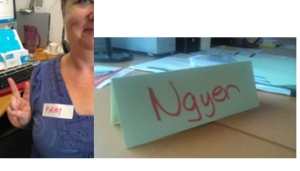It’s that time of year when you have a room full of bright eyed and fresh faced students looking to you for support and guidance and to the rest of the group with a mix of excitement, anxiety and uncertainty.
Welcome to first semester.
I was talking to a group of teachers about the start of semester and how they break the ice with students. “Asking names, where they went to school and why they chose the program” seemed popular and what about activities I asked? Speed dating was the reply, three of the five use the same icebreaker! Time for some research and to find:
5 introductory activities that aren’t speed dating
1. My name – having people know each other’s names is vital for cohesion in groups, here are two simple, cost effective, if slightly rustic options. two simple cost effective options
- use name tags for a couple of weeks to ensure that people have the chance to commit names to memory;
- if making name plates, use coloured paper as an easy way of finding them;
- write on both sides of the of the name plates so that people can read from different angles.
2. Split into similarities – the purpose of this activity to get students to identify similarities and talk to one another in a range of different group.
e.g. stand in the middle of the room and get students to break into groups 3-4 times on the basis of characteristics like the direction in which they live /whether they are oldest, middle youngest / how they got to uni and if by public transport, which line/. You could ask students for the criteria
3. Bingo – this is a way of getting students to meet and learn a little bit about other in the group – you can add more squares and contextualise the contents to make it relevant for your course/program
4. No stupid questions – this activity can be used as an icebreaker/energiser with a group who are new /inexperienced. The idea is that in pairs, then fours and so on you identify…..
Ask participants to write down one or 2 ‘stupid questions, things that they feel that they should know/others already know or that they would be embarrassed to ask in front of the group
To encourage candour give an example e.g. do we have to bring pens & paper to class? Do you ring our parents if we fail? Once this is done, get them to share with another person, encouraging them to try to answer, then move on to the group for any questions that have gone unanswered or not sure of the answer.
5. Business cards
Each student has a card with their name in centre and the answer to four specific questions in the corners. They can use this to meet others in the room and use card as a discussion starter.
Help students get to know each other and you and there will be benefits for them and for yourself:
- Making connections, with you and each other
- Hearing and being heard – speaking to and in front of peers can be a challenge for some, these activities allow them to do it in a non threatening way
- Having fun
There are many more introductory options, try Google, YouTube but remember:
- Be careful of the physical activities –you may not mind holding hands, running round the room, getting in a tangle with others, but not everyone feels the same give students a chance not to participate if they don’t feel comfortable
- If students choose not to participate in an activity, give them a role eg time keeper, observer, cheer squad – so they are involved.
- Keep activities sharp and focussed – they shouldn’t take over your teaching, suggest no more than ½ hour
Ruth Moeller

